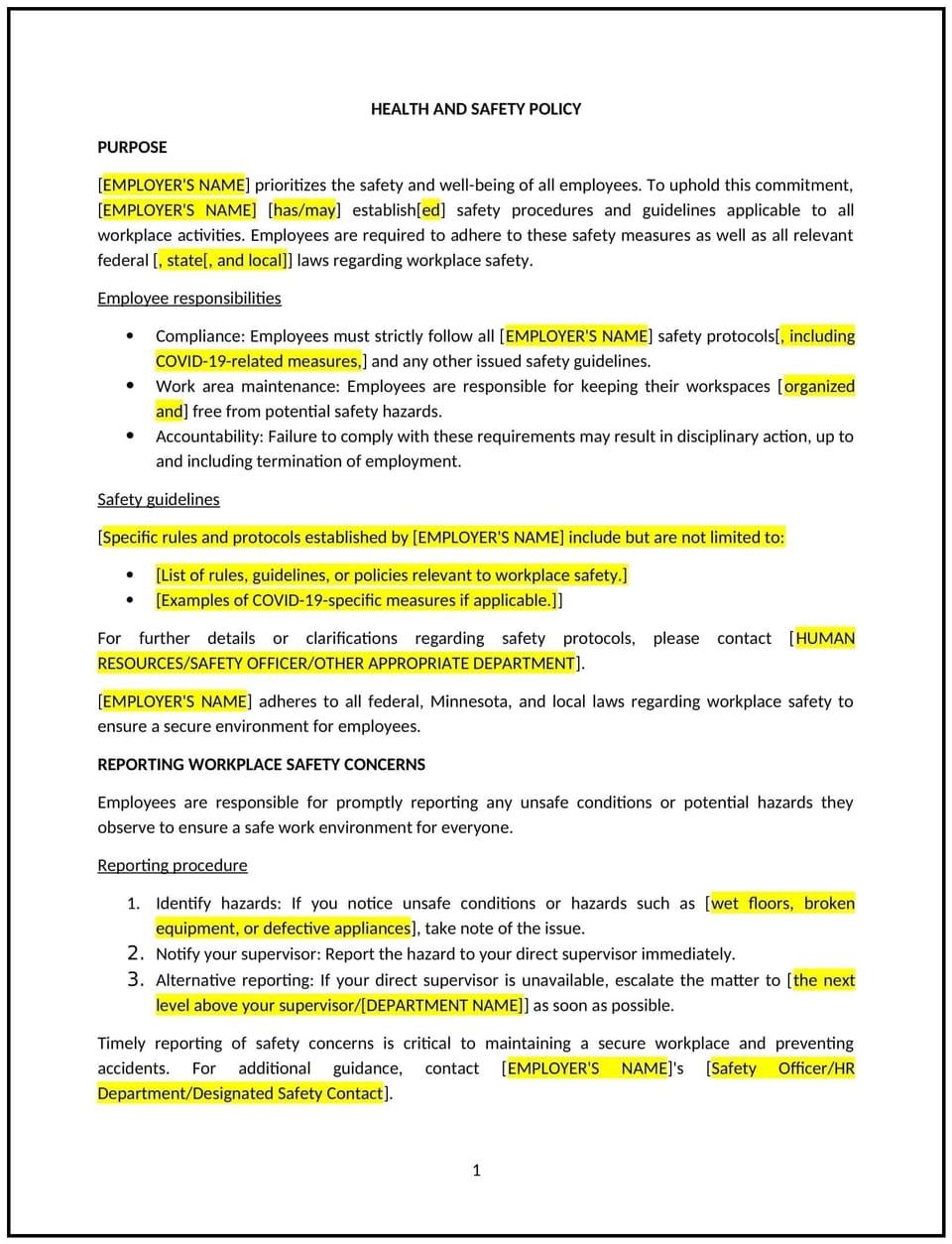Health and safety policy (Minnesota): Free template

Health and safety policy (Minnesota)
This health and safety policy is designed to help Minnesota businesses create and maintain a safe and healthy work environment for all employees. It outlines the responsibilities of both employers and employees in promoting workplace safety, preventing accidents, and addressing potential hazards. The policy covers procedures for reporting and addressing unsafe conditions, the roles of safety officers, and the steps businesses should take to reduce risks and protect their workforce.
By implementing this policy, businesses can reduce workplace injuries, foster employee well-being, and maintain a positive and productive workplace environment.
How to use this health and safety policy (Minnesota)
- Define workplace hazards: Identify the types of hazards that could exist in the workplace, including physical hazards (e.g., machinery, chemicals), ergonomic risks, psychological risks (e.g., workplace stress), and environmental factors (e.g., extreme weather).
- Establish safety protocols: Outline the safety procedures employees must follow to minimize the risk of accidents, including the use of personal protective equipment (PPE), safe operation of machinery, and emergency evacuation procedures.
- Assign responsibility for health and safety: Designate specific personnel, such as a safety officer or team, to oversee workplace health and safety practices, monitor compliance, and handle safety concerns.
- Provide training: Ensure all employees are trained in workplace safety practices, including recognizing hazards, using safety equipment, and responding to emergencies.
- Set up reporting procedures: Implement a system for employees to report unsafe conditions, accidents, or health concerns, ensuring prompt action and accountability.
- Implement emergency preparedness: Develop clear emergency response plans for potential situations, such as fires, medical emergencies, or natural disasters, and ensure employees know what to do in these cases.
Benefits of using a health and safety policy (Minnesota)
Implementing this policy provides several advantages for Minnesota businesses:
- Reduces accidents and injuries: A clear and enforced health and safety policy helps prevent accidents and injuries, minimizing downtime and improving overall productivity.
- Enhances employee well-being: By prioritizing health and safety, businesses show they care about employee welfare, which can boost morale and reduce absenteeism.
- Improves regulatory compliance: A well-structured policy helps ensure businesses comply with local and federal safety regulations, reducing the risk of penalties or legal issues.
- Boosts employee satisfaction and retention: A safe work environment is a key factor in employee satisfaction, leading to improved retention rates and a more positive company culture.
- Reflects Minnesota-specific considerations: Tailors the policy to meet Minnesota’s specific workplace safety regulations, weather conditions (such as winter weather preparedness), and industry-specific risks.
Tips for using this health and safety policy (Minnesota)
- Communicate clearly: Make sure all employees understand the safety protocols, know how to report hazards, and are aware of their responsibilities regarding health and safety.
- Regularly assess workplace risks: Conduct regular workplace inspections to identify new or emerging hazards, and take prompt corrective action to address them.
- Offer ongoing training: Provide continuous safety training, including refresher courses, to ensure employees remain informed and up-to-date on safety protocols.
- Encourage a safety culture: Promote a safety-first mentality in the workplace by rewarding safe behavior, encouraging open communication about safety issues, and actively involving employees in safety discussions.
- Review regularly: Reassess the policy annually or whenever there are significant changes in operations, regulations, or workplace conditions to ensure it remains effective and relevant.
Q: What types of hazards should be addressed in the workplace?
A: Businesses should identify and address a variety of hazards, including physical (e.g., machinery, chemicals), ergonomic (e.g., repetitive strain, poor workstation design), environmental (e.g., weather-related issues), and psychosocial (e.g., workplace stress, harassment).
Q: How can businesses prevent workplace accidents?
A: Businesses should conduct regular safety training, implement proper use of personal protective equipment (PPE), conduct regular safety inspections, and maintain a clear reporting process for hazards and accidents.
Q: Who is responsible for workplace health and safety?
A: Employers are responsible for providing a safe work environment and implementing safety procedures, while employees are responsible for following the safety protocols, reporting hazards, and working safely. Specific roles, such as safety officers, may be designated to oversee safety efforts.
Q: How should businesses handle a workplace injury?
A: Businesses should have clear procedures in place for reporting, documenting, and addressing injuries, including providing first aid, notifying supervisors, and seeking medical treatment when necessary. Additionally, employees should be informed about workers’ compensation procedures.
Q: What should employees do if they notice a safety hazard?
A: Employees should immediately report any safety hazard to their supervisor, safety officer, or through the company’s reporting system. Businesses should act quickly to assess and address the situation to prevent accidents.
Q: How can businesses prepare for emergencies?
A: Businesses should develop emergency response plans that include evacuation procedures, emergency contacts, and the use of emergency supplies. Employees should be trained on these procedures, and regular drills should be conducted to ensure preparedness.
Q: How often should the health and safety policy be reviewed?
A: The policy should be reviewed annually or when there are significant changes to the workplace environment, new risks, or changes to regulations. Regular updates ensure that safety practices remain effective and compliant.
Q: Can employees be penalized for reporting health and safety issues?
A: No, businesses should encourage employees to report hazards or unsafe conditions without fear of retaliation. An open reporting culture helps ensure that safety concerns are addressed promptly.
This article contains general legal information and does not contain legal advice. Cobrief is not a law firm or a substitute for an attorney or law firm. The law is complex and changes often. For legal advice, please ask a lawyer.


